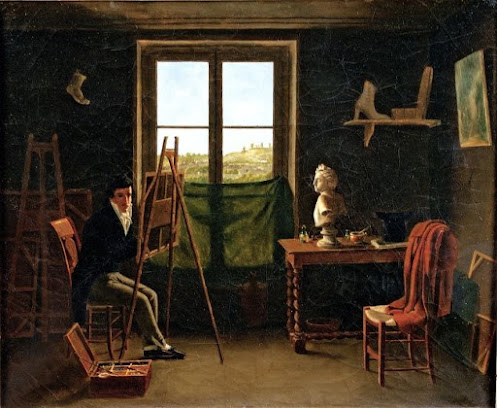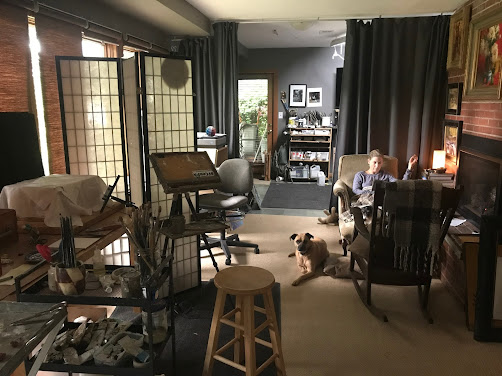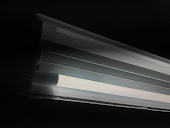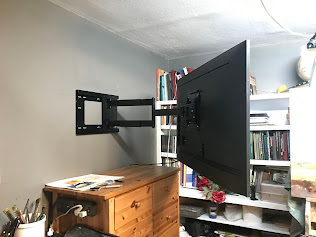Well clearly, it has been a long time since I posted, so here's something new!... But before I begin, I want to share I am teaching an awesome plein air workshop in Sicily this October, 17th - 24th, 2021. Italy is now open so we can eat some great pasta, drink some amazing wine, and paint some beautiful sun-drenched pictures!
Studio Lighting for Painters
I am largely known as an observational painter, an artist who prefers to work en plein air whenever possible, although I do paint a fair amount in my studio. Sometimes from a still life or model, and sometimes from a monitor. (gasp!) Yes, a monitor... 😳
I started off as a commercial illustrator, which has probably damned me to Fine Art Purgatory at the least, if not Hell itself. But as a result, I have no strong feelings about remaining artistically pure in any sense of the word. However, having confessed to my earlier sins, I do recognize the need to train one's self by working directly from life as much as possible. Painting from life hones your observational skills. Abilities which cannot be developed from looking at a photograph print or LED screen.
But I am posting this to share information about lighting your studio space, not argue about whether or not working from a photo is a sin. I'll leave that debate to others instead.
Most of us have turned part of our home into a studio...
It might be a corner of the kitchen table, or an entire floor of your house. In the beginning I lived in a tiny one-bedroom, second floor apartment and I use the small living room as my workspace. I didn't have a sofa, sitting chair, coffee table because they interfered with the easel. And as a young single artist living that way wasn't a problem. I could read in the kitchen or watch television in bed. But the idea of having to make do such a tiny space now, alone or with another person – let alone another artist, which I did – seems crazy now.
I am better off in my current studio. I may wish I had more room, with north facing windows – and I once did have such a space. But I had to vacate it when the building it was in was turned into an indoor growing-operation after weed became legal. (Pluses and minuses, right? 😁) I eventually ended up buying a mid-century modern daylight ranch on a slope with a large family room downstairs and that daylight basement works pretty well for me now. I still might wish for more space and north windows, but I am largely content with what I have.
However, the light in my studio sucks. There is a twelve-foot row of 60 inch windows along one wall so there is plenty of light. The problem is the windows face southwest, which means the natural light changes dramatically over the course of the day.
So what to do? Beyond turning my studio into a dark cave by shuttering the windows?
Supplement the Light...
Lighting has come a long way since my first apartment. What once was unacceptable is now easily fixed with our new lighting tech.
I used to hate LED lights and refused to use them in any way. Not on the house, not on the Christmas tree, not for reading, whatever. To me, LEDs felt cold, hard, and brash. The kind of light that sucked all the warmth and romance out of my work. But LEDs have changed. We can now buy (relatively) inexpensive color-corrected, full-spectrum lights in a wide range of formats and temperatures. You can find temperatures from 2700k (which is similar to a 100 watt tungsten bulb), to 3000k, 4000k, 5000k, and 6500k LED bulbs. All with form factors which can be inserted into standard sockets and fixtures.
But LED specifications are still new and confusing to many painters, which can make it difficult to choose the right ones to augment the deficient light in your studio.
So let me describe my studio space...
Approximately 17 by 35 feet.
A single bank of 120 x 60 inch windows facing southwest. (Aaaak!)
Two hard-wired ceiling fixtures towards the opposite ends of the studio, on a single wall switch.
A ceiling height of 8 feet, 4 inches. (An important point to consider when designing your lighting set up. This is low for good studio lighting.)
Oh, and lately, I've been sharing the space with my wife, who is painting again after many years.
A long shot of my entire studio. In the foreground are tables and areas dedicated to painting the still life and indoors instruction. To the left is the large bank of windows with various screens used to control the outdoor light. My painting area is at the back, where I work from a monitor. And in the mid-ground, a fireplace that make everything so cozy I never want to leave. Oh, and my lovely wife and our two dogs as well. It is nice to have visitors every now and then...
My primary painting area: The panel on the easel is 30 x 40 inches and the monitor behind it is a fairly new 55-inch 4k Samsung with a reference image thrown onto the screen directly from my laptop.
My Current Lighting Hardware:
Two daylight balanced 3000k LED bulbs in two ceiling fixtures. Both are on a dimmer switch so the lumens may be adjusted as needed. A total of 4 bulbs. Note the two different colors used to reduce the temperature bias. (I often view a painting only under these lights because they represent the temperatures and lumens found in most homes.)
One 48 LED tube inserted into a cheap light fixture. The light hangs 8 inches above the top mast of my easel and slightly out front. With older lighting technology this would be an insolvable problem. But the LED light tube is so diffused it feels as if the light is coming down from a light well ten to twelve feet above my head. It provides a beautiful even wash.
I also have two adjustable LED easel lights purchased from ArtEscape.us. (Image courtesy of Douglas Woodman, inventor and purveyor of a fine easel lighting system. I use these lights for painting nocturnes but also to illuminate an indoor still life or model. I have 10, 20, and 24 inch light bars that connect to long-running battery packs, or switched cords that can be plugged into a socket for continual power. The temperature and lumens of these lights are widely adjustable so I can match to the light found in any nook or cranny in the studio, which increases the useful space by a large margin, or I can dial in a complementary color temperatures as a teaching tool.
48 inch ArtEscape Light Bar clamp to a large easel.
Photo and painting courtesy of Doug Woodman.
👉 QUICK TIP: If you are just looking for a quick and easy solution for your easel then I recommend ArtEscape's LED light tubes. They can illuminate a canvas from a 6 x 8 to a 36 x 48 inches. Even larger, actually. (In fact, since every light is hand made Doug would be happy to custom build you any size light. His lights may seem pricey but they provide you with a simple and immediate solution. I guarantee his light(s) will improve your experience at your easel.) Doug is literally a rocket scientist, now retired, and he paints like you. You simply clamp his light on, plug it in, and start painting.
But how can you find a good lighting solution?
Let's start by defining a few important terms. Once you understand them you can decide what will work in your studio.
Day-light Balanced Bulb: A term used by manufacturers to claim the color of their light matches the color of the sun at noon on a clear day. Technically, this spec usually runs between 5000k and 6500k – 'k' being a symbol to indicate the Kelvin scale. The Kelvin scale is used by physicists to quantify the visual temperature of a light source. I originally installed 6500k daylight balanced LED lights in my studio but decided the 6500k threshold was too cool for painting indoors and collectors will almost always display the artwork they own under warmer lights.) So the term "Daylight Balanced" is not all that helpful since the temperature of the light can be what is claimed, yet the light can still be deficient in multiple parts of the spectrum.

https://en.wikipedia.org/wiki/Color_rendering_index
LED lights commonly come in a range between 2700k to 7200k, although I wouldn't recommend anything below 4000k or above 5000k for your studio. In my experience, both 4000k and 5000k are a decent compromise between the temperatures you experience outdoors and the lighting you find in most homes.
👉 Lumens: Lumens quantify how much light a light source emits. We once used watts to describe the brightness of a bulb but this has changed due to the new kinds of light now available. To put it simply, the higher the lumens, the stronger or brighter the light.
https://en.wikipedia.org/wiki/Lumen_(unit)
It is easy to over light your studio just as it is easy to accidentally set up your easel outdoors with the canvas pointed too directly at the sun – a situation that is guaranteed to turn your beautiful plein air painting into a black hole when you bring it indoors. So my advice is to match the lumens that fall on your studio easel with the lumens you find in most homes lest you end up painting a black hole in your studio as well. I started off lighting my painting space with two 48 inch light bars but removed one of them because the lumens were too much. I was creating black holes on the easel as well.Ooooh, look at all those beautiful colors going down the drain and into a black hole!... 😉
But what about painting from a monitor?...
There are a few tricks to setting up a monitor in your studio. In addition to supplementing my natural studio light with LED technology, I have a new 4k 55-inch HDTV mounted to the wall on a 30 inch folding arm. (The 4k refers to the pixel resolution of the monitor and has nothing to do with the temperature of light.) The HDTV can be pulled over to my easel and angled for easy comparison. The swinging wall mount also allows me to rotate the screen 90 degrees for when I paint a vertical canvas. The monitor turns without a need to unscrew, unlock, or reset anything. I just reach out and rotate it. It's a nice feature to have and worth the extra $$$. This HDTV has wifi built-in so my references are transmitted directly from my laptop as shown below.
Something to note: Since the HDTV is not a computer monitor my ability to calibrate its screen is limited. So I set the HDTV to its factory default of 'Natural' and tune the reference image for pleasing color from my laptop. The image may look awful on my laptop but I don't care. It is how the image looks on the big screen that counts.And speaking of painting from a monitor, it is important to balance or equalize the lumens of the light on your canvas with the lumens coming out of your painting monitor. You also do not want the area around the monitor to be too dark or you may have difficulty gauging the values and colors in your reference. So make an effort to balance both areas of light.
And finally, I have hung curtains in such a way that they can be opened or closed to eliminate reflections from windows or lights elsewhere in the studio. It is a good to plan out your workspace before buying the hardware. And know that even if you do plan well you will probably still need to tweak things after everything is installed. If only to make the painting environment perfect!
Supplier Links...The 48 light bar above my easel:
I am using one D50 5000k T8 LED Tube Light.
The ArtEscapes Easel lights
If you have questions about anything in this post please don't hesitate to ask. I'll be happy to respond!
TJK
And remember, I am teaching a fantastic workshop in Sicily, October, 17 - 24, 2021. Among other helpful things, we will focus on the temperature of light and how to add it into the light and shadows of your paintings to create life and atmosphere. This will be one of my best workshops ever!
Registration now open!...








































